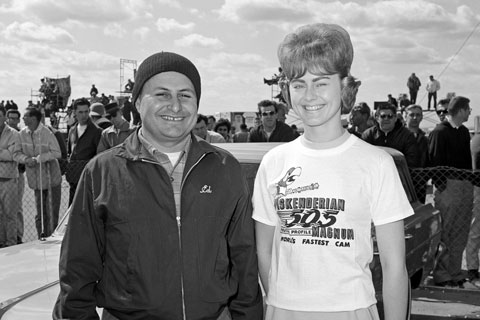SEMA News—September 2012
HERITAGE
By Drew Hardin
Photo Courtesy of the Petersen Archives
Going 90
 |
|
No, the 90 we’re referring to is Xydias’ age, a milestone he celebrated recently with some 400 friends at a festive party held at California’s Pomona Fairplex, just a stone’s throw away from the historic dragstrip where the coupe made its record run nearly six decades ago.
Alex Xydias is among a select group of true hot-rodding pioneers and founders of the performance industry. He built several hot rods and raced on the Southern California dry lakes before World War II, then opened one of the very first automotive performance retail stores in the country—the original SO-CAL Speed Shop—on the day he mustered out of the Army Air Corps in 1946.
“We carried chrome carb stacks, steel wheels, acorn carb nuts…we couldn’t afford much,” he said at the party about his early inventory. But he also established relationships with other rodding pioneers, men like Vic Edelbrock, Barney Navarro and Eddie Meyer, and SO-CAL’s stock began to fill with real speed parts.
To promote the business, Xydias built and raced a string of successful cars: belly tankers, streamliners, the coupe shown here. At the very first speed trials at Bonneville in 1949, his SO-CAL streamliner, with Dean Batchelor at the wheel, ran an astonishing 193 mph, some 30 mph faster than the record set on the lakes just a month before. Xydias and his SO-CAL cars were so successful, and so photogenic, that they made several appearances on the cover of Hot Rod magazine.
Yet Xydias abruptly quit racing shortly after an accident in the Double Threat Coupe took the life of another SO-CAL team member. He began filming races and other car events, eventually closed the speed shop and then went to work for Petersen Publishing Company in 1963. While there, he was instrumental in putting on the High Performance & Custom Equipment Trade Show at Dodger Stadium in January 1967, an event that evolved into the SEMA Show.
Another milestone in Xydias’s life took place in 1997, when he and rod builder Pete Chapouris struck a deal to revive the SO-CAL Speed Shop name. They opened the shop in Pomona, building high-quality hot rods and custom cars and retailing everything from turn-key Deuce roadsters to T-shirts. Now there are eight SO-CAL Speed Shops around the country, plus one in Canada.
“It’s worked out really well,” Xydias said of the reborn SO-CAL. “I’ve had a great time.”
Silent and live auctions were held during Xydias’ birthday party to raise funds for the Alex Xydias Center for Automotive Arts—a vocational school located on the Pomona Fairplex grounds. Among the treasures offered were some of his original racing trophies, including the one his team won at that first Bonneville meet in 1949.
It commanded the highest bid of the evening, at $15,000. “We didn’t spend that much on the whole car that won the award,” Xydias said.
What’s next for Alex Xydias? He shows no signs of slowing down. Look for him at this year’s SEMA Show. He hasn’t missed one since 1967.






